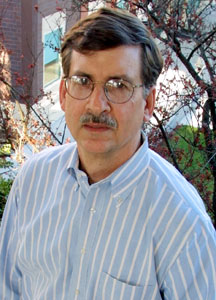![[Metroactive News&Issues]](/gifs/news468.gif)
[ North Bay | Metroactive Central | Archives ]
Photograph by Michael Amsler
Money Matters
Living-wage advocates get to work
By Greg Cahill
THE SONOMA COUNTY Living Wage Coalition is ready to make its first bid at a municipal ordinance establishing--what else?--a livable wage in Santa Rosa. The coalition will present its case on Tuesday, Oct. 23, at 4 p.m., to the Santa Rosa City Council. Supporters of the measure--including the Sonoma County Council on Aging, the Sonoma County Peace and Justice Center, the North Bay Labor Council, and Women in Action--have fashioned the living-wage ordinance on similar measures adopted in San Francisco, San Jose, and Santa Cruz, which now require contractors and subcontractors doing business with those cities to pay workers $15 an hour, plus benefits.
The City Council chambers are located at 100 Santa Rosa Ave., Santa Rosa.
As a member of the coalition organizing committee, Marty Bennett--a history instructor at Santa Rosa Junior College--is helping to organize a phone bank on Oct. 14 and 24 to educate the public about the movement and invite new organizations to join the coalition.
"We're in the process of crafting living-wage ordinances for Petaluma and Santa Rosa and will be working with those two city councils as we proceed," says Bennett. "Over time, we will go from one municipality to the next, and ultimately we'll go to the county Board of Supervisors."
Petaluma Vice Mayor Janice Cader-Thompson says that while she is concerned that the new council majority will not support such an ordinance, she fully embraces it. "If we just look at the cost of living in Sonoma County, we should see it's something we need to address--it's not possible to live and work in this county at a minimal wage," she says. "I think it's important for this issue to come to the forefront."
Bennett believes the time is ripe for building a local living-wage movement at the grassroots level for several reasons. "This movement is sweeping the country," he says, noting that more than 50 cities and counties in the nation have passed similar ordinances since the movement began in the 1990s.
For more information about the living-wage ordinance, call 707/545-7349, ext. 48.
Bioneering Spirit
It's billed as "America's largest gathering focusing on practical solutions to the world's most urgent environmental and social issues." And, Lord knows, there will plenty to occupy the nearly 3,000 scientists, educators, authors, activists, business leaders, doctors, policymakers, and artists expected to attend the 12th annual Bioneers Conference.The confab--held Oct. 19-21 at the Marin Center in San Rafael--will zero in on such heavyweight issues as global warming, chemical toxicity and human health, and the destruction of indigenous cultures. Among the speakers are holistic health poster boy Dr. Andrew Weil, housewife-turned-activist Diane Wilson, civil rights attorney J. L. Chestnut, progressive business leader Anita Roddick of the Body Shop, and treesitter-turned-author Julia Butterfly Hill. For registration info, call 877/246-6337 or visit www.bioneers.org.
That Hurts!
Here's mud in your eye: The feds are taking another look at a controversial pepper-spraying case. The U.S. Supreme Court last week ordered the 9th U.S. Circuit Court of Appeals to reconsider its ruling that lawsuits can be filed against law enforcement officers who dabbed liquefied pepper spray directly into the eyes of logging protesters at the office of Rep. Frank Riggs in 1997. In a lengthy court battle, a federal judge had ruled that the spray caused only "transient pain," but the appellate court decided the unusual tactic--in which police filled Dixie Cups with liquefied pepper spray and then dabbed it directly into the eyes with cotton swabs--constituted a breach of ethics and made police liable for damages. The U.S. Supreme Court wants a second ruling, noting that a separate case--stemming from a demonstrator pepper-sprayed by federal agents guarding then Vice President Al Gore--may have set the precedent for protection of law enforcement officials who use the chemical weapon in the line of duty. Attorneys for the demonstrators argue that the protesters posed no threat, unlike the man who was pepper-sprayed in the Gore case.
[ North Bay | Metroactive Central | Archives ]
Copyright © Metro Publishing Inc. Maintained by Boulevards New Media.
![]()
 Man With A Plan: SRJC instructor and labor activist Marty Bennett.
Man With A Plan: SRJC instructor and labor activist Marty Bennett.
From the October 18-24, 2001 issue of the Northern California Bohemian.